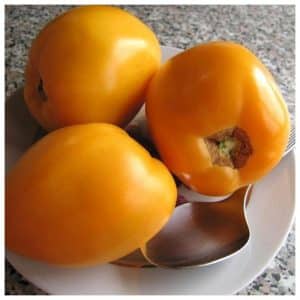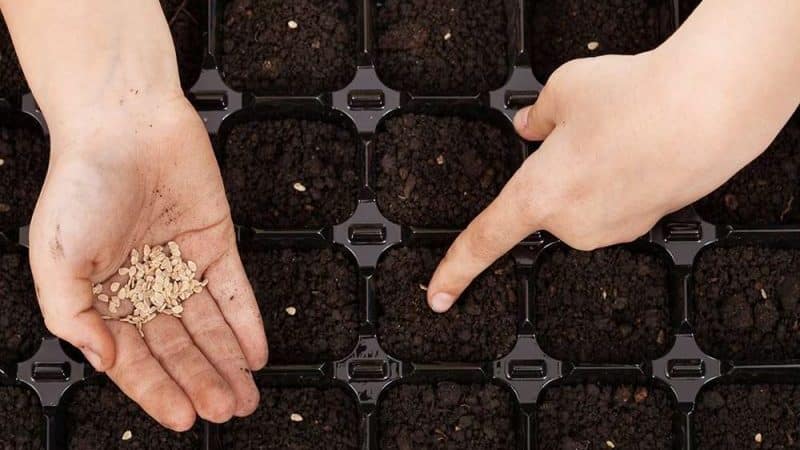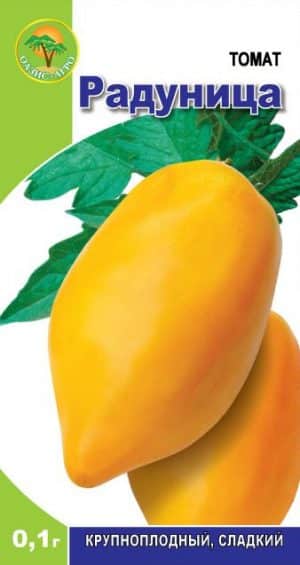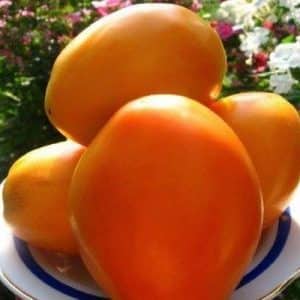A bright representative of mid-season productive varieties is the Radunitsa tomato and tips for its proper cultivation
For children's and dietary nutrition, doctors recommend using yellow-fruited tomatoes. They are low in calories and rarely cause allergies, unlike red fruits. They contain more beta-carotene, lycopene and other beneficial substances.
A popular representative of yellow tomatoes is Radunitsa. It produces bright fruits that will decorate the garden and dining table.
General description of the variety
The Radunitsa tomato is popular among gardeners in the former CIS countries. Its seeds are produced by companies such as Sedek and Siberian Garden.
The tomato was bred by domestic breeders and included in the Russian state register in 2008.
Advice! Seeds from the fruits of Radunitsa are used for planting. Since this is a variety and not a hybrid, the plant retains all its properties. According to gardeners, self-collected planting material has a 99% germination rate.
Distinctive features
The main feature of Radunitsa is the bright yellow-orange color of the fruit. At the beginning of ripening they are completely yellow, but if they are allowed to hang on the bush, the fruits take on an orange tint.
The shape of the fruit is also unusual. Those who have grown this variety say that it resembles a rocket.
The fruit tastes sweet with a slight sourness. The pulp is tender, but juicy; The aroma is rich.
Reference. Yellow-fruited tomatoes contain a lot of useful substances. In addition to vitamin C, B and PP, they contain beta-carotene.It increases visual acuity, stimulates the synthesis of growth hormone and has a positive effect on the condition of the skin and hair. Lycopene in tomatoes helps cleanse the body of waste, toxins and free radicals. It improves the condition of the cardiovascular system and fights pathogenic microflora in the intestines. Myocin is also present in the pulp, which strengthens blood vessels and capillaries.
 The variety has average immunity to nightshade diseases. According to gardeners, bushes are often affected by crown and root rot.
The variety has average immunity to nightshade diseases. According to gardeners, bushes are often affected by crown and root rot.
Radunitsa is resistant to adverse environmental conditions. In the southern and central regions, it has excellent yields both in the greenhouse and in the open ground.
Main characteristics
Many gardeners believe that Radunitsa has a better taste than most other yellow-fruited tomatoes. Unlike other varieties, to achieve high yields, it is not necessary to plant it in a greenhouse.
Characteristics and description of the variety:
| Parameter | Indicators |
| Bush type | Indeterminate. Medium height. Each plant reaches 1.4-1.6 m in height. The bushes form a small number of stepsons. There are few leaves on the plant. The leaf blade is large, dark green, similar to a potato leaf. The internodes on the bush are short. The inflorescences are simple. The first is laid in the axil of 7-6 leaves, the next through each leaf. The fruits are formed in clusters. Each of them produces 5-7 tomatoes. |
| Growing method | It is grown in a greenhouse and in open ground. In the northern regions, cultivation is possible only in protected soil. |
| Productivity | Average. Up to 3.5 kg of tomatoes are harvested from 1 bush. From 1 sq. m get up to 13 kg of fruit. |
| Fruit | Medium size. One tomato weighs from 150 to 200 g.Sometimes large fruits weighing 300 g are found. The color of the shell and pulp is yellow-orange. A greenish spot may be present at the base. The shape is obovate, with slight ribbing at the base. The taste is sweet, with sourness and rich aroma. There is a lot of pulp, it is tender and juicy. Inside each fruit there are from 4 to 6 chambers with a small number of seeds. |
| Transportability | High. Tomatoes have thin but tough skin. It protects them from cracking during transportation. |
| Ripening time | Mid-season. The fruits ripen 115-120 days after sowing the seeds. |
| Disease resistance | Has average resistance to tomato diseases. |
How to grow seedlings
Mid-season tomatoes in Russia are grown exclusively by seedlings. Otherwise, they simply will not have time to ripen before the onset of cold weather.
Usually the seeds are sown in March 55-60 days before planting in a permanent place. Before growing seedlings, gardeners are advised to familiarize themselves with the indicators of the lunar calendar.
Seed preparation
Before planting, seeds are treated with special compounds. They reduce the risk of plant infection and increase their resistance to adverse environmental factors.
Preparing seeds for planting:
- Checking planting material for germination. The seeds are soaked in a solution prepared from a glass of warm water and 1 tsp. salt. Floating seeds are considered unsuitable for planting; they are collected and thrown away. The specimens that have sunk to the bottom are washed and used.
- Disinfection of planting material to prevent plant infection. The seeds are soaked for 20 minutes in a solution of potassium permanganate or hydrogen peroxide. Another option is to soak them overnight in a growing solution.
- Stimulation of seed growth. This procedure not only accelerates the appearance of the first shoots, but also increases the plants' resistance to unfavorable environmental conditions. Planting material is soaked in Epin, Sodium Humate and Zircon.
Selection of container and soil
To grow seedlings, take large boxes of shallow depth. Sow seeds both in small plastic cups and in individual peat tablets.
When the seedlings grow, they are planted in individual pots. Use plastic or peat containers with a volume of at least 300 ml.
 The soil for tomatoes should be nutritious, but light. Suitable soil mixtures are sold in gardening stores.
The soil for tomatoes should be nutritious, but light. Suitable soil mixtures are sold in gardening stores.
Many gardeners prepare the soil for tomato seedlings themselves in the following ways:
- humus, black soil and sand are mixed in equal proportions;
- take equal parts of wood or coconut sawdust and garden soil;
- peat is mixed with the same amount of sand, and ash is added to the composition.
The soil and containers are disinfected before use: treated with a dark pink solution of potassium permanganate.
Advice! It is convenient to grow seedlings in cake packaging. In this case, the transparent cover will act as a film.
Sowing planting material
Soil is poured into the boxes for sowing seeds. It is watered generously with warm water. Grooves 1 cm deep are made in the soil. Seeds are placed in them at a distance of 2 cm from each other.
The grooves are covered with soil that is not compacted. The containers are covered with film and placed in a warm place.
Growing and care
To grow healthy and vital seedlings, it is important to provide her with proper care.
The list shows the basic rules for caring for plants:
- Before the seeds germinate, as the soil dries, it is moistened with a spray bottle. When the first shoots appear, they are watered so that the liquid gets only under the root. Water is used at room temperature.
- After all seeds have germinated, the film is removed. To prevent the plants from stretching, they are transferred to a cool room for a week.
- Tomatoes begin to sprout when real leaves appear on them. A layer of disinfected drainage (broken ceramics, brick, expanded clay, shell rock, small crushed stone) is poured onto the bottom of individual pots. It will reduce the risk of seedling disease. It is important to ensure that there are holes in the bottom of each container.
- The seedlings are fed three times during the entire growing period. The first time is 12 days after picking the plants, the next feedings are done with an interval of 2 weeks. For these purposes, it is convenient to use chicken manure diluted in a ratio of 1:10 with the addition of superphosphate.
- 14 days before picking, the seedlings begin to harden. It is taken out onto the balcony or onto the street. The duration of the first procedure does not exceed 1 hour, then gradually the hardening time is increased to 16 hours.
Note! If a layer of mold appears on the soil in which the seeds were sown, then the problem lies in excessive watering. To correct the situation, the affected soil layer is removed, the boxes are dried, and the ground is watered with a light pink solution of potassium permanganate. A layer of clean soil is poured on top.
How to grow tomatoes
Tomatoes are planted in the ground when the soil temperature at a depth of 15 cm reaches 15 °C. In the southern regions this happens at the end of April, and in the central regions - in the second half of May. In cities with a northern climate, Radunitsa is grown in greenhouses.
Planting seedlings in a permanent place
For tomatoes, choose a well-lit area of the garden. The more sun the tomatoes receive, the sweeter they will be.
In the fall, the beds are prepared. They are dug up to a depth of 20 cm and cleared of plant remains. Humus is added to the soil, 6 kg per 1 sq. m, and dry lime (if the acidity of the soil is increased).
Lifehack from experienced gardeners! In November, rye is sown in tomato beds. In the spring, when it germinates, the soil is dug up so that the plants are underground and watered with Baikal.
 In spring, the beds are leveled with a rake and cleared of weeds. The soil is watered with a solution of chicken manure.
In spring, the beds are leveled with a rake and cleared of weeds. The soil is watered with a solution of chicken manure.
The holes are dug in rows in a checkerboard pattern. For 1 sq. m plant 3-4 plants.
Ash or long-term mineral fertilizers are poured into the bottom of the holes. If you planted rye in the fall, then this is not necessary.
Seedlings are watered and fed 3 days before planting. Immediately before picking, it is removed from the pots along with a lump of earth and immediately placed in the hole, forming a root system towards the center. The depressions are filled with soil, which is compacted.
After picking, water the tomatoes. Take 1 liter of warm water per plant. The next time the tomatoes are watered and fed no earlier than a week later.
Basic rules of care
Tomato Radunitsa needs garter. It is attached to the support with a synthetic thread as it grows. Heavy bunches with fruits that have set will also have to be tied up.
Radunitsa is formed into 1 or 2 stems. The best performance is observed precisely when forming a tomato into 2 trunks.
During the process of pinching, you need to remove excess greenery. All leaves below the first flower cluster, as well as withered and limp ones, are cut off. This procedure is carried out once a week.For one pinching, no more than 3 leaves are removed.
Water the tomatoes as the soil dries out. At least 2 liters of water are consumed per plant. On the day of planting, the soil is not moistened.
After each watering, the soil is loosened. This is necessary to destroy the earthen crust, which prevents root air exchange and evaporation of liquid. During the loosening process, the beds are cleared of weeds.
It is recommended to mulch the beds with straw, peat, hay or humus. Such a layer will slow down the growth of weeds and protect the roots of the plant from adverse weather conditions, infections and pests. Mulch also acts as an additional feeding.
Not all gardeners agree with the need to hill tomatoes. Be sure to do this if new roots form on the tomato stems.
During the season, fertilizing is applied three times. There are many fertilizer application schemes, here is one of them:
- For the first time, fertilizers are applied 2 weeks after transplanting the seedlings to a permanent place. Tomatoes are fed with a mixture of superphosphate, urea and potassium salt. For 1 sq. m take 20 g of dry substances.
- Second time tomatoes feed in 14-21 days. Use chicken manure diluted 1:10 with water. Add 1 matchbox of superphosphate to a bucket of mixture.
- When the ovaries form, add a third feeding. Use complex fertilizers, including potassium and phosphorus.
Common problems
When growing tomatoes, gardeners often face a number of difficulties.
The most common of them:
- Tomato leaves change their appearance. If the leaf blade is curled, this indicates a lack of potassium. Purple spots on the leaves indicate fluoride deficiency.
- Plants have stopped growing.This problem indicates a lack of nitrogen.
- The plants began to wither after applying fertilizers. This happens if feeding was introduced without prior watering of the beds.
- Tomatoes “fatten” (they produce a large amount of greenery, but do not set fruit). This occurs when there is an excess of nitrogenous fertilizers.
- Plants have lost turgor (become lethargic and yellowed). If there are no signs of disease, then the problem lies in improper watering.
- The tomatoes are tasteless and watery. This happens when too much greenery is removed from the plant.
Diseases and pests
Tomato Radunitsa has low immunity to plant diseases. For this reason, it is important to follow the rules of prevention, which include disinfection of all objects that the plants come into contact with and compliance with crop rotation.
The most common tomato diseases:
- Late blight. The leaves and fruits of the plant turn black. It is impossible to cure the disease. For prevention, tomatoes are sprayed with iodine solution or purchased antifungal agents (Baktofit).
- Alternaria blight. Plants become covered with small black spots. At the beginning of the development of the disease, Quadris is used.
- Anthracnose. The leaves dry out and depressed brown spots form on the fruits. For prevention, “Quadris” is used. For treatment - solutions with Bacillus subtilis.
- Gray rot. The bushes are covered with a gray coating. Bayleton is used as a preventive measure.
- Powdery mildew. The greens of the tomatoes are covered with white spots. To combat the disease, sodium humate is used.
The nuances of growing in open ground and in a greenhouse
 Before planting tomatoes, the walls of the greenhouse are disinfected: wiped with copper sulfate.
Before planting tomatoes, the walls of the greenhouse are disinfected: wiped with copper sulfate.
To reduce the likelihood of plant infection, and at the same time the level of humidity in the room, ventilate the greenhouse daily by opening the windows.
To help pollinate tomatoes in the greenhouse, the bushes are shaken regularly. Another option is to put a fan on in the room.
In open ground, for the first two weeks after picking, tomatoes are covered with film to prevent their death due to night frosts. Watering in such conditions should be more frequent than in a greenhouse.
Harvesting and application
Radunitsa is harvested in August; tomatoes of this variety ripen at the same time. The fruits are picked both individually and on the bushes.
Tomatoes are consumed fresh. They are suitable for whole preservation and processing into tomato juice and sauces.
Advantages and disadvantages of the variety
 Advantages of Radunitsa:
Advantages of Radunitsa:
- rich sweet taste of fruits;
- high content of useful substances in the composition with low allergenicity;
- possibility of cultivation in open and protected ground;
- good yield indicators;
- high transportability.
Disadvantages of the variety:
- the need for gartering and pinching;
- low immunity to diseases.
Farmer reviews
Feedback from farmers about Radunitsa is mostly positive. This variety has gained popularity.
Galina, Voronezh: “I’ve been planting Radunitsa for the second year now. The first time a tomato got rot. The next time, when growing, I periodically sprayed it with a solution of potassium permanganate, and diseases were avoided. As for the fruits, they are very tasty. The sweetest of all the yellow tomatoes I've tried. The brushes are beautiful, just like in the photo.”
Ivan, Belgorod: “I’ve been growing Radunitsa for 5 years. I form bushes with 2 stems. I collect up to a bucket of tomatoes from two plants. The fruits are tasty and beautiful.The only negative is that there are few seeds in tomatoes. You have to leave at least 5 pieces on the bush to fully ripen in order to get enough seeds for the next planting. I collect the seeds, peel them from the pulp and store them in fabric bags.”
Conclusion
Tomato Radunitsa is a variety that will appeal to experienced and novice gardeners. It produces yellow fruits with excellent taste - sweet, with a slight sourness. Due to their low allergenicity, they are approved for consumption even by small children.
Growing yellow tomatoes is easy. The main thing is to plant plants in a timely manner and follow the basic rules for disease prevention.